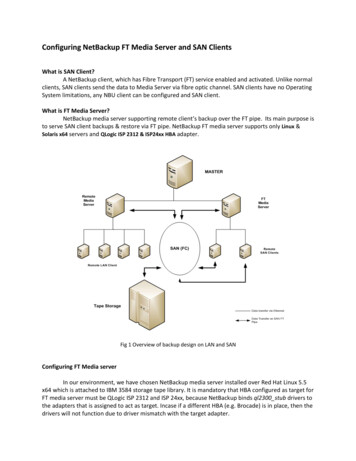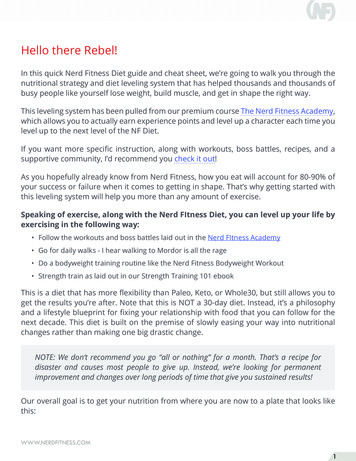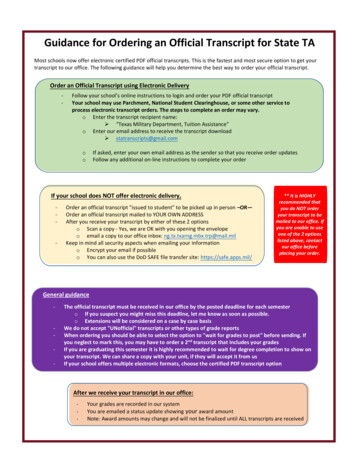
Transcription
HelloWorldBeing Humanin the Age of AlgorithmsHANNAH FRYW. W. NORTON & COMPANYIndependent Publishers Since 1923NEW YORK LONDON
For Marie Fry.Thank you for never taking no for an answer.
ContentsA note on the ArtConclusionAcknowledgementsPhotograph CreditsNotesIndex
A note on the titleWI WAS 7 YEARS old, my dad brought a gift home for me and my sisters.It was a ZX Spectrum, a little 8-bit computer – the first time we’d ever hadone of our own. It was probably already five years out of date by the time itarrived in our house, but even though it was second-hand, I instantly thoughtthere was something marvellous about that dinky machine. The Spectrum wasroughly equivalent to a Commodore 64 (although only the really posh kids inthe neighbourhood had one of those) but I always thought it was a far morebeautiful beast. The sleek black plastic casing could fit in your hands, andthere was something rather friendly about the grey rubber keys and rainbowstripe running diagonally across one corner.HENFor me, the arrival of that ZX Spectrum marked the beginning of amemorable summer spent up in the loft with my elder sister, programminghangman puzzles for each other, or drawing simple shapes through code. Allthat ‘advanced’ stuff came later, though. First we had to master the basics.Looking back, I don’t exactly remember the moment I wrote my first evercomputer program, but I’m pretty sure I know what it was. It would havebeen the same simple program that I’ve gone on to teach all of my students atUniversity College London; the same as you’ll find on the first page ofpractically any introductory computer science textbook. Because there is atradition among all those who have ever learned to code – a rite of passage,almost. Your first task as a rookie is to program the computer to flash up afamous phrase on to the screen:‘HELLO WORLD’It’s a tradition that dates back to the 1970s, when Brian Kernighanincluded it as a tutorial in his phenomenally popular programming textbook.1The book – and hence the phrase – marked an important point in the historyof computers. The microprocessor had just arrived on the scene, heralding thetransition of computers from what they had been in the past – enormous greatspecialist machines, fed on punch cards and ticker-tape – to something morelike the personal computers we’re used to, with a screen, a keyboard and ablinking cursor. ‘Hello world’ came along at the first moment when chit-chatwith your computer was a possibility.Years later, Brian Kernighan told a Forbes interviewer about hisinspiration for the phrase. He’d seen a cartoon showing an egg and a newlyhatched chick chirping the words ‘Hello world!’ as it was born, and it had
stuck in his mind.It’s not entirely clear who the chick is supposed to be in that scenario: thefresh-faced human triumphantly announcing their brave arrival to the worldof programming? Or the computer itself, awakening from the mundaneslumber of spreadsheets and text documents, ready to connect its mind to thereal world and do its new master’s bidding? Maybe both. But it’s certainly aphrase that unites all programmers, and connects them to every machine that’sever been programmed.There’s something else I like about the phrase – something that has neverbeen more relevant or more important than it is now. As computer algorithmsincreasingly control and decide our future, ‘Hello world’ is a reminder of amoment of dialogue between human and machine. Of an instant where theboundary between controller and controlled is virtually imperceptible. Itmarks the start of a partnership – a shared journey of possibilities, where onecannot exist without the other.In the age of the algorithm, that’s a sentiment worth bearing in mind.
IntroductionAJones Beach on Long Island, New York, willhave driven under a series of bridges on their way to the ocean. Thesebridges, primarily built to filter people on and off the highway, have anunusual feature. As they gently arc over the traffic, they hang extraordinarilylow, sometimes leaving as little as 9 feet of clearance from the tarmac.NYONE WHO HAS EVER VISITEDThere’s a reason for this strange design. In the 1920s, Robert Moses, apowerful New York urban planner, was keen to keep his newly finished,award-winning state park at Jones Beach the preserve of white and wealthyAmericans. Knowing that his preferred clientele would travel to the beach intheir private cars, while people from poor black neighbourhoods would getthere by bus, he deliberately tried to limit access by building hundreds of lowlying bridges along the highway. Too low for the 12-foot buses to pass under.1Racist bridges aren’t the only inanimate objects that have had a quiet,clandestine control over people. History is littered with examples of objectsand inventions with a power beyond their professed purpose.2 Sometimes it’sdeliberately and maliciously factored into their design, but at other times it’s aresult of thoughtless omissions: just think of the lack of wheelchair access insome urban areas. Sometimes it’s an unintended consequence, like themechanized weaving machines of the nineteenth century. They were designedto make it easier to create complicated textiles, but in the end, the impact theyhad on wages, unemployment and working conditions made them arguablymore tyrannical than any Victorian capitalist.Modern inventions are no different. Just ask the residents of Scunthorpe inthe north of England, who were blocked from opening AOL accounts after theinternet giant created a new profanity filter that objected to the name of theirtown.3 Or Chukwuemeka Afigbo, the Nigerian man who discovered anautomatic hand-soap dispenser that released soap perfectly whenever hiswhite friend placed their hand under the machine, but refused to acknowledgehis darker skin.4 Or Mark Zuckerberg, who, when writing the code forFacebook in his dorm room in Harvard in 2004, would never have imaginedhis creation would go on to be accused of helping manipulate votes inelections around the globe.5Behind each of these inventions is an algorithm. The invisible pieces ofcode that form the gears and cogs of the modern machine age, algorithmshave given the world everything from social media feeds to search engines,
satellite navigation to music recommendation systems, and are as much a partof our modern infrastructure as bridges, buildings and factories ever were.They’re inside our hospitals, our courtrooms and our cars. They’re used bypolice forces, supermarkets and film studios. They have learned our likes anddislikes; they tell us what to watch, what to read and who to date. And all thewhile, they have the hidden power to slowly and subtly change the rules aboutwhat it means to be human.In this book, we’ll discover the vast array of algorithms on which weincreasingly, but perhaps unknowingly, rely. We’ll pay close attention to theirclaims, examine their undeclared power and confront the unansweredquestions they raise. We’ll encounter algorithms used by police to decide whoshould be arrested, which make us choose between protecting the victims ofcrime and the innocence of the accused. We’ll meet algorithms used by judgesto decide on the sentences of convicted criminals, which ask us to decidewhat our justice system should look like. We’ll find algorithms used bydoctors to over-rule their own diagnoses; algorithms within driverless carsthat insist we define our morality; algorithms that are weighing in on ourexpressions of emotion; and algorithms with the power to undermine ourdemocracies.I’m not arguing that algorithms are inherently bad. As you’ll see in thesepages, there are many reasons to be positive and optimistic about what liesahead. No object or algorithm is ever either good or evil in itself. It’s howthey’re used that matters. GPS was invented to launch nuclear missiles andnow helps deliver pizzas. Pop music, played on repeat, has been deployed as atorture device. And however beautifully made a garland of flowers might be,if I really wanted to I could strangle you with it. Forming an opinion on analgorithm means understanding the relationship between human and machine.Each one is inextricably connected to the people who build and use it.This means that, at its heart, this is a book about humans. It’s about whowe are, where we’re going, what’s important to us and how that is changingthrough technology. It’s about our relationship with the algorithms that arealready here, the ones working alongside us, amplifying our abilities,correcting our mistakes, solving our problems and creating new ones alongthe way.It’s about asking if an algorithm is having a net benefit on society. Aboutwhen you should trust a machine over your own judgement, and when youshould resist the temptation to leave machines in control. It’s about breakingopen the algorithms and finding their limits; and about looking hard atourselves and finding our own. About separating the harm from the good anddeciding what kind of world we want to live in.
Because the future doesn’t just happen. We create it.
PowerGKASPAROV KNEW EXACTLY HOW to intimidate his rivals. At 34, he wasthe greatest chess player the world had ever seen, with a reputation fearsomeenough to put any opponent on edge. Even so, there was one unnerving trickin particular that his competitors had come to dread. As they sat, sweatingthrough what was probably the most difficult game of their life, the Russianwould casually pick up his watch from where it had been lying beside thechessboard, and return it to his wrist. This was a signal that everybodyrecognized – it meant that Kasparov was bored with toying with his opponent.The watch was an instruction that it was time for his rival to resign the game.They could refuse, but either way, Kasparov’s victory was soon inevitable.1ARRYBut when IBM’s Deep Blue faced Kasparov in the famous match of May1997, the machine was immune to such tactics. The outcome of the match iswell known, but the story behind how Deep Blue secured its win is lesswidely appreciated. That symbolic victory, of machine over man, which inmany ways marked the start of the algorithmic age, was down to far morethan sheer raw computing power. In order to beat Kasparov, Deep Blue had tounderstand him not simply as a highly efficient processor of brilliant chessmoves, but as a human being.For a start, the IBM engineers made the brilliant decision to design DeepBlue to appear more uncertain than it was. During their infamous six-gamematch, the machine would occasionally hold off from declaring its move oncea calculation had finished, sometimes for several minutes. From Kasparov’send of the table, the delays made it look as if the machine was struggling,churning through more and more calculations. It seemed to confirm whatKasparov thought he knew; that he’d successfully dragged the game into aposition where the number of possibilities was so mind-bogglingly large thatDeep Blue couldn’t make a sensible decision.2 In reality, however, it wassitting idly by, knowing exactly what to play, just letting the clock tick down.It was a mean trick, but it worked. Even in the first game of the match,Kasparov started to become distracted by second-guessing how capable themachine might be.3Although Kasparov won the first game, it was in game two that DeepBlue really got into his head. Kasparov tried to lure the computer into a trap,tempting it to come in and capture some pieces, while at the same time settinghimself up – several moves ahead – to release his queen and launch anattack.4 Every watching chess expert expected the computer to take the bait,
as did Kasparov himself. But somehow, Deep Blue smelt a rat. To Kasparov’samazement, the computer had realized what the grandmaster was planningand moved to block his queen, killing any chance of a human victory.5Kasparov was visibly horrified. His misjudgement about what thecomputer could do had thrown him. In an interview a few days after thematch he described Deep Blue as having ‘suddenly played like a god for onemoment’.6 Many years later, reflecting on how he had felt at the time, hewould write that he had ‘made the mistake of assuming that moves that weresurprising for a computer to make were also objectively strong moves’.7Either way, the genius of the algorithm had triumphed. Its understanding ofthe human mind, and human fallibility, was attacking and defeating the alltoo-human genius.Disheartened, Kasparov resigned the second game rather than fighting forthe draw. From there his confidence began to unravel. Games three, four andfive ended in draws. By game six, Kasparov was broken. The match endedDeep Blue 3½ to Kasparov’s 2½.It was a strange defeat. Kasparov was more than capable of working hisway out of those positions on the board, but he had underestimated the abilityof the algorithm and then allowed himself to be intimidated by it. ‘I had beenso impressed by Deep Blue’s play,’ he wrote in 2017, reflecting on the match.‘I became so concerned with what it might be capable of that I was obliviousto how my problems were more due to how badly I was playing than howwell it was playing.’8As we’ll see time and time again in this book, expectations are important.The story of Deep Blue defeating the great grandmaster demonstrates that thepower of an algorithm isn’t limited to what is contained within its lines ofcode. Understanding our own flaws and weaknesses – as well as those of themachine – is the key to remaining in control.But if someone like Kasparov failed to grasp this, what hope is there forthe rest of us? Within these pages, we’ll see how algorithms have crept intovirtually every aspect of modern life – from health and crime to transport andpolitics. Along the way, we have somehow managed to be simultaneouslydismissive of them, intimidated by them and in awe of their capabilities. Theend result is that we have no idea quite how much power we’re ceding, or ifwe’ve let things go too far.Back to basicsBefore we get to all that, perhaps it’s worth pausing briefly to question what‘algorithm’ actually means. It’s a term that, although used frequently,
routinely fails to convey much actual information. This is partly because theword itself is quite vague. Officially, it is defined as follows:9algorithm (noun): A step-by-step procedure for solving a problem oraccomplishing some end especially by a computer.That’s it. An algorithm is simply a series of logical instructions that show,from start to finish, how to accomplish a task. By this broad definition, a cakerecipe counts as an algorithm. So does a list of directions you might give to alost stranger. IKEA manuals, YouTube troubleshooting videos, even self-helpbooks – in theory, any self-contained list of instructions for achieving aspecific, defined objective could be described as an algorithm.But that’s not quite how the term is used. Usually, algorithms refer tosomething a little more specific. They still boil down to a list of step-by-stepinstructions, but these algorithms are almost always mathematical objects.They take a sequence of mathematical operations – using equations,arithmetic, algebra, calculus, logic and probability – and translate them intocomputer code. They are fed with data from the real world, given an objectiveand set to work crunching through the calculations to achieve their aim. Theyare what makes computer science an actual science, and in the process havefuelled many of the most miraculous modern achievements made bymachines.There’s an almost uncountable number of different algorithms. Each hasits own goals, its own idiosyncrasies, its clever quirks and drawbacks, andthere is no consensus on how best to group them. But broadly speaking, it canbe useful to think of the real-world tasks they perform in four maincategories:10Prioritization: making an ordered listGoogle Search predicts the page you’re looking for by ranking oneresult over another. Netflix suggests which films you might like towatch next. Your TomTom selects your fastest route. All use amathematical process to order the vast array of possible choices. DeepBlue was also essentially a prioritization algorithm, reviewing all thepossible moves on the chessboard and calculating which would give thebest chance of victory.Classification: picking a categoryAs soon as I hit my late twenties, I was bombarded by adverts fordiamond rings on Facebook. And once I eventually got married, advertsfor pregnancy tests followed me around the internet. For these mildirritations, I had classification algorithms to thank. These algorithms,
loved by advertisers, run behind the scenes and classify you as someoneinterested in those things on the basis of your characteristics. (Theymight be right, too, but it’s still annoying when adverts for fertility kitspop up on your laptop in the middle of a meeting.)There are algorithms that can automatically classify and removeinappropriate content on YouTube, algorithms that will label yourholiday photos for you, and algorithms that can scan your handwritingand classify each mark on the page as a letter of the alphabet.Association: finding linksAssociation is all about finding and marking relationships betweenthings. Dating algorithms such as OKCupid have association at theircore, looking for connections between members and suggestingmatches based on the findings. Amazon’s recommendation engine usesa similar idea, connecting your interests to those of past customers. It’swhat led to the intriguing shopping suggestion that confronted Reddituser Kerbobotat after buying a baseball bat on Amazon: ‘Perhaps you’llbe interested in this balaclava?’11Filtering: isolating what’s importantAlgorithms often need to remove some information to focus on what’simportant, to separate the signal from the noise. Sometimes they do thisliterally: speech recognition algorithms, like those running inside Siri,Alexa and Cortana, first need to filter out your voice from thebackground noise before they can get to work on deciphering whatyou’re saying. Sometimes they do it figuratively: Facebook and Twitterfilter stories that relate to your known interests to design your ownpersonalized feed.The vast majority of algorithms will be built to perform a combination of theabove. Take UberPool, for instance, which matches prospective passengerswith others heading in the same direction. Given your start point and endpoint, it has to filter through the possible routes that could get you home, lookfor connections with other users headed in the same direction, and pick onegroup to assign you to – all while prioritizing routes with the fewest turns forthe driver, to make the ride as efficient as possible.12So, that’s what algorithms can do. Now, how do they manage to do it?Well, again, while the possibilities are practically endless, there is a way todistil things. You can think of the approaches taken by algorithms as broadlyfitting into two key paradigms, both of which we’ll meet in this book.Rule-based algorithms
The first type are rule-based. Their instructions are constructed by ahuman and are direct and unambiguous. You can imagine thesealgorithms as following the logic of a cake recipe. Step one: do this.Step two: if this, then that. That’s not to imply that these algorithms aresimple – there’s plenty of room to build powerful programs within thisparadigm.Machine-learning algorithmsThe second type are inspired by how living creatures learn. To give youan analogy, think about how you might teach a dog to give you a highfive. You don’t need to produce a precise list of instructions andcommunicate them to the dog. As a trainer, all you need is a clearobjective in your mind of what you want the dog to do and some way ofrewarding her when she does the right thing. It’s simply aboutreinforcing good behaviour, ignoring bad, and giving her enoughpractice to work out what to do for herself. The algorithmic equivalentis known as a machine-learning algorithm, which comes under thebroader umbrella of artificial intelligence or AI. You give the machinedata, a goal and feedback when it’s on the right track – and leave it towork out the best way of achieving the end.Both types have their pros and cons. Because rule-based algorithms haveinstructions written by humans, they’re easy to comprehend. In theory,anyone can open them up and follow the logic of what’s happening inside.13But their blessing is also their curse. Rule-based algorithms will only work forthe problems for which humans know how to write instructions.Machine-learning algorithms, by contrast, have recently proved to beremarkably good at tackling problems where writing a list of instructionswon’t work. They can recognize objects in pictures, understand words as wespeak them and translate from one language to another – something rulebased algorithms have always struggled with. The downside is that if you let amachine figure out the solution for itself, the route it takes to get there oftenwon’t make a lot of sense to a human observer. The insides can be a mystery,even to the smartest of living programmers.Take, for instance, the job of image recognition. A group of Japaneseresearchers recently demonstrated how strange an algorithm’s way of lookingat the world can seem to a human. You might have come across the opticalillusion where you can’t quite tell if you’re looking at a picture of a vase or oftwo faces (if not, there’s an example in the notes at the back of the book).14Here’s the computer equivalent. The team showed that changing a single pixelon the front wheel of the image overleaf was enough to cause a machine-
learning algorithm to change its mind from thinking this is a photo of a car tothinking it is a photo of a dog.15For some, the idea of an algorithm working without explicit instructions isa recipe for disaster. How can we control something we don’t understand?What if the capabilities of sentient, super-intelligent machines transcend thoseof their makers? How will we ensure that an AI we don’t understand and can’tcontrol isn’t working against us?These are all interesting hypothetical questions, and there is no shortageof books dedicated to the impending threat of an AI apocalypse. Apologies ifthat was what you were hoping for, but this book isn’t one of them. AlthoughAI has come on in leaps and bounds of late, it is still only ‘intelligent’ in thenarrowest sense of the word. It would probably be more useful to think ofwhat we’ve been through as a revolution in computational statistics than arevolution in intelligence. I know that makes it sound a lot less sexy (unlessyou’re really into statistics), but it’s a far more accurate description of how
things currently stand.For the time being, worrying about evil AI is a bit like worrying aboutovercrowding on Mars.* Maybe one day we’ll get to the point wherecomputer intelligence surpasses human intelligence, but we’re nowhere nearit yet. Frankly, we’re still quite a long way away from creating hedgehoglevel intelligence. So far, no one’s even managed to get past worm.†Besides, all the hype over AI is a distraction from much more pressingconcerns and – I think – much more interesting stories. Forget aboutomnipotent artificially intelligent machines for a moment and turn yourthoughts from the far distant future to the here and now – because there arealready algorithms with free rein to act as autonomous decision-makers. Todecide prison terms, treatments for cancer patients and what to do in a carcrash. They’re already making life-changing choices on our behalf at everyturn.The question is, if we’re handing over all that power – are they deservingof our trust?Blind faithSunday, 22 March 2009 wasn’t a good day for Robert Jones. He had justvisited some friends and was driving back through the pretty town ofTodmorden in West Yorkshire, England, when he noticed the fuel light on hisBMW. He had just 7 miles to find a petrol station before he ran out, whichwas cutting things rather fine. Thankfully his GPS seemed to have found hima short cut – sending him on a narrow winding path up the side of the valley.Robert followed the machine’s instructions, but as he drove, the road gotsteeper and narrower. After a couple of miles, it turned into a dirt track thatbarely seemed designed to accommodate horses, let alone cars. But Robertwasn’t fazed. He drove five thousand miles a week for a living and knew howto handle himself behind the wheel. Plus, he thought, he had ‘no reason not totrust the TomTom’.16Just a short while later, anyone who happened to be looking up from thevalley below would have seen the nose of Robert’s BMW appearing over thebrink of the cliff above, saved from the hundred-foot drop only by the flimsywooden fence at the edge he’d just crashed into.It would eventually take a tractor and three quad bikes to recover Robert’scar from where he abandoned it. Later that year, when he appeared in court oncharges of reckless driving, he admitted that he didn’t think to over-rule themachine’s instructions. ‘It kept insisting the path was a road,’ he told anewspaper after the incident. ‘So I just trusted it. You don’t expect to be taken
nearly over a cliff.’17No, Robert. I guess you don’t.There’s a moral somewhere in this story. Although he probably felt a littlefoolish at the time, in ignoring the information in front of his eyes (like seeinga sheer drop out of the car window) and attributing greater intelligence to analgorithm than it deserved, Jones was in good company. After all, Kasparovhad fallen into the same trap some twelve years earlier. And, in much quieterbut no less profound ways, it’s a mistake almost all of us are guilty of making,perhaps without even realizing.Back in 2015 scientists set out to examine how search engines like Googlehave the power to alter our view of the world.18 They wanted to find out if wehave healthy limits in the faith we place in their results, or if we wouldhappily follow them over the edge of a metaphorical cliff.The experiment focused around an upcoming election in India. Theresearchers, led by psychologist Robert Epstein, recruited 2,150 undecidedvoters from around the country and gave them access to a specially madesearch engine, called ‘Kadoodle’, to help them learn more about thecandidates before deciding who they would vote for.Kadoodle was rigged. Unbeknown to the participants, they had been splitinto groups, each of which was shown a slightly different version of thesearch engine results, biased towards one candidate or another. Whenmembers of one group visited the website, all the links at the top of the pagewould favour one candidate in particular, meaning they’d have to scroll rightdown through link after link before finally finding a single page that wasfavourable to anyone else. Different groups were nudged towards differentcandidates.It will come as no surprise that the participants spent most of their timereading the websites flagged up at the top of the first page – as that oldinternet joke says, the best place to hide a dead body is on the second page ofGoogle search results. Hardly anyone in the experiment paid much attentionto the links that appeared well down the list. But still, the degree to which theordering influenced the volunteers’ opinions shocked even Epstein. After onlya few minutes of looking at the search engine’s biased results, when askedwho they would vote for, participants were a staggering 12 per cent morelikely to pick the candidate Kadoodle had favoured.In an interview with Science in 2015,19 Epstein explained what was goingon: ‘We expect the search engine to be making wise choices. What they’resaying is, “Well yes, I see the bias and that’s telling me the search engine is
doing its job.”’ Perhaps more ominous, given how much of our informationwe now get from algorithms like search engines, is how much agency peoplebelieved they had in their own opinions: ‘When people are unaware they arebeing manipulated, they tend to believe they have adopted their new thinkingvoluntarily,’ Epstein wrote in the original paper.20Kadoodle, of course, is not the only algorithm to have been accused ofsubtly manipulating people’s political opinions. We’ll come on to that more inthe ‘Data’ chapter, but for now it’s worth noting how the experiment suggestswe feel about algorithms that are right most of the time. We end up believingthat they always have superior judgement.21 After a while, we’re no longereven aware of our own bias towards them.All around us, algorithms provide a kind of convenient source ofauthority. An easy way to delegate responsibility; a short cut that we takewithout thinking. Who is really going to click through to the second page ofGoogle every time and think critically about every result? Or go to everyairline to check if Skyscanner is listing the cheapest deals? Or get out a rulerand a road map to confirm that their GPS is offering the shortest route? Notme, that’s for sure.But there’s a distinction that needs making here. Because trusting ausually reliable algorithm is one thing. Trusting one without any firmunderstanding of its quality is quite another.Artificial intelligence meets natural stupidityIn 2012, a number of disabled people in Idaho were informed that theirMedicaid assistance was being cut.22 Although they all qualified for benefits,the state was slashing their financial support – without warning – by as muchas 30 per cent,23 leaving them struggling to pay for their care. This wasn’t apolitical decision; it was the result of a new ‘budget tool’ that had beenadopted by the Idaho Department of Health and Welfare – a piece of softwarethat automatically calculated the level of support that each person shouldreceive.24The problem was, the budget tool’s decisions didn’t seem to make muchsense. As far as anyone could tell from the outside, the numbers it came upwith were essentially arbitrary. Some peo
In this book, we’ll discover the vast array of algorithms on which we increasingly, but perhaps unknowingly, rely. We’ll pay close attention to their claims, examine their undeclared power and confront the unanswered questions they rai











